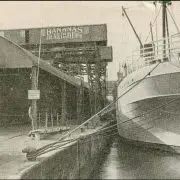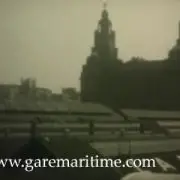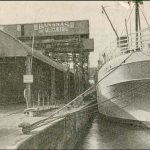Two Year Articles and All That
Our first port of call on the Australian coast was Geelong where we discharged a part cargo before proceeding to Newcastle, Portland, Cairns, Gladstone and Townsville. Whilst going up the East coast on one of our trips towards the Great Barrier Reef on our way to Townsville, we encountered quite an unusual event. Watch keeping on this ship comprised of just two AB’s and a Deck Boy/ Ordinary Seaman, with one on the wheel, the other on lookout and one on standby, relieving the other two. That night I was on the twelve to four watch and doing my two hour trick on the wheel with one of the AB’s on lookout on the fo’c’sle. Around 0100 hours with about a force five blowing, we were pitching into a moderate sea with water gushing up through the hawespipes and a bit of spray breaking over the fo’c’sle head. It doesn’t take much on a loaded tanker for this to happen and the Lookout quite rightly phoned the bridge to ask if he could continue his lookout duties up on the ‘monkey island’ above the wheelhouse.
This is normal procedure and after the officer of the watch allowed him to do so, we could just barely see his shape in the darkness through the wheelhouse windows as he made his way aft along the flying bridge. At that time when he was about half way along, the bow rose up almost as though the ship started to climb a steep hill and rose ever higher until suddenly, she plunged as from a great height, burying her fo’c’sle head into huge solid mass of water. The fore part of the ship went completely under as a solid wall of water smashed against the fore part of the bridge and wheelhouse windows. The stern had risen so high that her single screw was thrashing around in mid air causing massive vibration throughout the vessel. Many of the crew aft had been thrown out of their bunks or awakened by the din as the crashing and banging could be heard amidships.
The skipper arrived on the bridge in his underpants as if from nowhere and immediately looked into the compass and then going onto the wing of the bridge, asked the 2nd Mate if the Lookout Man had still been on the fo’c’sle head. It had indeed been the Lookout Man’s lucky day by just a matter of seconds! We learned later that when he felt her bow going up, he didn’t hang around and made a dash for it.
Just as quickly as it had happened, the sea settled down again and it was considered a freak wave and just one of those unexpected occurrences at sea. No one onboard had ever experienced anything quite like it and once again a freakish event like that must answer some of the questions as to why many vessels throughout history had disappeared without trace.
We returned to Singapore after no less than three crew had jumped ship at various ports around the Australian coast and in their place we had signed on DBS seamen. (Distressed British Seamen) These were men that had been put ashore at some time or other from British ships mainly due to medical or other problems and were now fit enough to work their passages back to the UK. They had been told that we would be returning to the UK shortly but it looks as though ‘Shanghai Jack’ must have had an accomplice working for him in Australia as well as we’d heard no such thing!
On arrival in Singapore once again, our orders were to do another run around the Australian coast and then back again for another full load of various grades of spirits. We had been away for over a year now and the men were getting a bit fed up with just about everything. Several of the ships officers were granted leave to go home and Hughie the Chief Steward was sent packing. This had been a long time coming due to his inability to cater for the crew properly and came to a head on this particular trip with the food running out a day before arriving in Singapore. There had been many complaints from everyone about the same unappetising fodder and we were all glad to see him go! All of our dry stores were full of weevils and we ate them with everything as a matter of course as to go without, hunger would have been a bigger problem than it already was.
On our next run down under, I can remember quite clearly another incident whilst on lookout that broke the monotony during the watch. During the night on lookout it’s generally quiet and lonely up on the fo’c’sle of a tanker and you get used to the gentle ‘swish’ of water breaking away from the bow and at times, dolphins playing games in the wash of the bow wave. Sometimes when racing towards the ship’s bow, the phosphorous would light up their trails and they would look like torpedoes heading towards the ship.. Lookouts during the war must have had some frightening moments when these animals decided to play games around their ships.
On this particular night all was quiet when suddenly there was a loud gush of air and water as a huge tail rose up out of the sea coming up level with the fo’c’sle head , before crashing back into the water. This almost caused an evacuation of the bowels until I realised that we had struck a whale and immediately reported the incident to the officer of the watch.
Back in Singapore, a life threatening incident that involved all hands and just about everyone else in the surrounding area was about to take place as we were loading several grades of spirits. A tanker that is loading and has partially filled tanks with high flash point liquids develops a high gas presence and is considered to be at it’s most dangerous during the loading process. We were in that kind of volatile situation when just ahead of us, a large vessel was coming in to berth immediately astern of us and had just developed complete power failure on her approach.
The only emergency procedure at a time like this was to drop both anchors as tugs were not in attendance for these berths as they were easily accessible from the harbour. As the ship approached with quite a bit of way on her, both anchors were immediately dropped but it was soon becoming clear that the action taken would have little effect.
It was looking as though she was going to collide with our starboard side if her anchors didn’t hold and all hands raced around looking for fenders. This was futile of course because apart from there being no time act, ships of this size need enormous fenders that would have to be hoisted over the side with the use of a derrick or a purchase of some sort. Our Pumpman realising the danger immediately got us to shut down as many valves as possible and dived below to shut off other valves in the pump room as the 2nd Mate got on to the emergency phone to stop all pumping from ashore. The anchors had not gained the necessary purchase to take the way off of her and within about a half minute or so, she struck us on the starboard side just forward of the bridge. The vessel was a tanker of about 20,000 tons and luckily as we heard later, in ballast. On impact, she heeled over considerably making a thunderous roar as she continued to drag anchors, scraping and grinding along our ship side buckling plates, popping rivets, causing paintwork, rust and sparks to fly everywhere. With huge clouds of rust, dust and smoke billowing up between both vessels, the smell of friction was everywhere as the ship finally came to rest further on up the quay after ripping a few wooden piles out of the dockside on the way. The strong smell of gasses wafting about our decks along with those extremely volatile liquids sloshing around in our tanks had turned our ship into a massive bomb, ready to explode. One theory later was that the mixture at the time of colliding was too rich to ignite but looking back, I wouldn’t want to bet on it ! Just about everyone that day realised how lucky we all were, especially with the other ship being gas free and not being so highly charged as us.
As ‘Dead legs’ put it after the collision, ‘ We could have all been on our way to the bloody moon by now!’
Shortly after the collision, marine surveyors descended on the ship and with our master, took a launch to inspect the forward starboard side for damage along the water line. Apart from a fleet of buckled plates, sheered off rivets and the lack of paintwork, we were lucky enough to remain sound as far as springing any leaks were concerned. It was decided that our cargo would have to be pumped ashore again and the ship gas freed, ballasted and then set sail for Hong Kong and dry docked immediately.
On arrival at the anchorage in Hong Kong harbour, we were to learn that after 16 months they were finally going to let us fly home. After dry docking, the Niso would be fully crewed up with a Chinese crew and remain in the Far East.
For most of the crew, flying was a new experience, flying at 17 000 feet by BOAC on an Argonaut refuelling just about everywhere and arriving at London’s Heathrow two and a half days later !
The above is an extended adaptation from David Haisman’s book, Raised On The Titanic © David Haisman 2003




